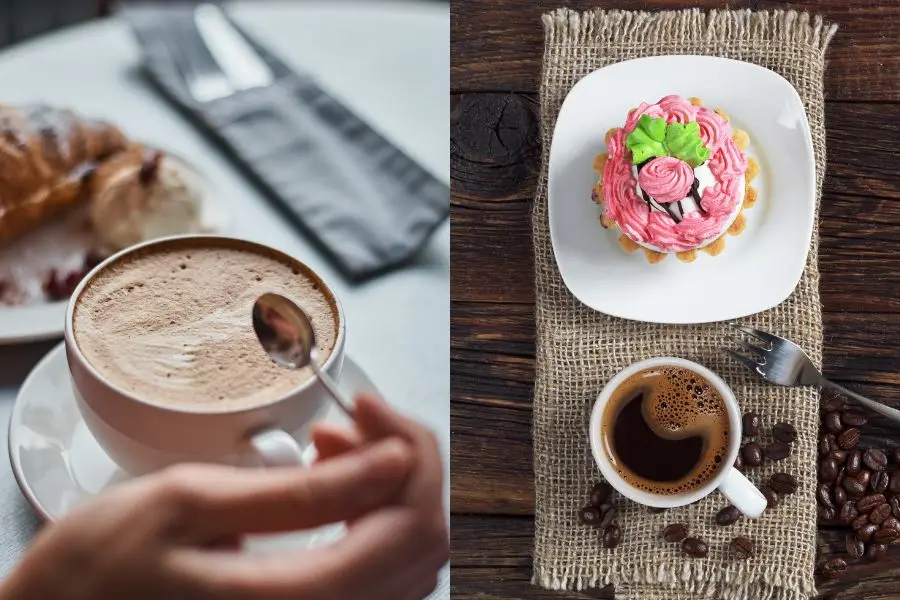How Much Caffeine Is In An Espresso Shot? 4 Influencing Factors

According to a global survey, there are many coffee variations, in which espresso makes up 32.83% of people’s daily consumption1. This figure proves espresso’s popularity in countries and how it plays a crucial role in people’s lives. Espresso is a perfect kit that’s worth sipping every single day for a quick boost. However, the caffeine content of espresso varies from regular coffee cups. Therefore, if you wonder how much caffeine is in an espresso shot, let’s delve into some essential details you need to know.
What Is Exactly A Single “Shot” Of Espresso?
When you order an espresso, the barista will serve it in “shots” – typically as a single shot, double shot, or triple shot. As its name suggests, a standard single shot of espresso has one fluid ounce, which requires roughly 7 to 9 grams of ground coffee and the brew ratio is 1 part coffee to 2 parts water. The espresso shot can be small in size, but it features a densely concentrated flavor in every sip by pressurizing and extracting ground coffee using a coffee machine.
In addition, every region owns its own style of making a perfect shot of espresso due to some factors. The flavor can depend on coffee beans, grind size, coffee machine as espresso made from a French press or Espresso maker,… brewing techniques, and customer demand as well.
Safety Caffeine Intake Daily You Must Know

Caffeine consumption offers both advantages and disadvantages. Let’s take a look at how caffeine in coffee affects your health and the recommended daily intake for safe consumption.
How Does Caffeine In Coffee Affect Your Health?
We all know the health benefits of caffeine, such as boosting alertness by stimulating the central nervous system, aiding in weight management, and acting as a diuretic. However, there is less scientific research supporting these advantages of caffeine. Despite this, many people today tend to overconsume coffee. Prolonged overindulgence in coffee can lead to negative side effects, including insomnia, headaches, dizziness, and a rapid heart rate, among others.
How Much Caffeine Should You Consume Daily?
According to the FDA in 2024, no more than 400 milligrams is an ideal coffee intake daily2. For those who may not know, caffeine is also present in many everyday foods and drinks (tea, energy drinks, soft drinks, to name but a few). For example, a cup of green tea contains about 30 to 50 mg of caffeine, and an ounce of dark chocolate-covered espresso has nearly 12 mg. Therefore, you should consume 1 to 2-ounce shots of espresso only daily in order not to exceed the safe caffeine consumption.
Moreover, according to the American College of Obstetricians and Gynecologists (ACOG), pregnant women should limit caffeine intake to no more than 200 mg per day3. Exceeding that amount can cause miscarriage or preterm birth. Therefore, a shot of espresso may not be a good choice during this sensitive period.
How Much Caffeine Is In An Espresso Shot?
According to the USDA, the average amount of caffeine in a single espresso shot accounts for 63 milligrams4. However, this figure varies among different types of espresso, some coffee shops might prefer a strong and potent shot, leading to the increase in caffeine content. Take Starbucks as an example, if you order a Starbucks espresso shot, you’ll consume 75 milligrams of caffeine in your body.
In addition, Here’s an overview in the estimated content of caffeine in various espresso beverages below:
- A single or 1-ounce shot of espresso: 63 mg of caffeine.
- A double (Doppio) or 2-ounce shot of espresso: Around 120 mg of caffeine.
A Shot Of Espresso Vs. A Regular Cup Of Coffee

The notable difference between a cup of coffee and an espresso is the foamy crema that forms on top of every espresso shot in diverse shapes as decorations. This unique feature cannot be found in any regular cups of coffee. The crema texture is created when hot water under high pressure emulsifies the coffee oils, resulting in a rich, velvety froth unique to espresso. This crema layer helps enhance the aroma and flavor of the expresso, making it unique from other types of coffee.
| Aspect | Standard Coffee (8 oz) | Espresso (1 oz shot) |
| Caffeine Content | 95 milligrams | 63 milligrams |
| Caffeine Concentration | 12-16 milligrams per ounce | 63 milligrams per ounce |
| Portion Size | Standard serving size: 8 ounces | Single shot: 1 ounce |
| Daily Consumption Impact | Consuming 4-5 cups is within safe limits | Consuming 5 shots exceeds safe intake |
| Potential Effects | Moderate caffeine intake is generally safe | Excessive intake may cause negative effects |
The comparison between standard coffee and espresso
4 Factors Influencing Caffeine Content in Espresso
The question “How much caffeine is in an espresso shot?” has no accurate answer because of the differences in some aspects. Let’s discover the main factors that can affect the amount of caffeine in an espresso shot.
Origin and type of coffee beans
There are numerous types of espresso beans and coffee beans around the world. The caffeine content of coffee varies depending on the bean you use. Liberica beans are rarer than other beans, tend to have a low caffeine content and a unique flavor with a light fruity aroma. If you don’t like too much caffeine, you can choose Liberia. Excelsa beans are grown extensively in Southeast Asia, have a medium caffeine content of around 1-1.5%, and a flavor that is a mix of mild acidity and richness.
Brewing Method And Pressure
The brewing method can directly affect the caffeine amount. Let’s take espresso and drip coffee as an example. The longer brewing time using high pressure in espresso can increase caffeine extraction per ounce, compared to drip coffee. Even though a single shot of espresso has 1 fluid ounce, its caffeine measurement might equal that of a regular 8-ounce cup of drip coffee servings.
Coffee Grind and Size
The grind size of the coffee beans plays an important role in the extraction of caffeine. Finely ground beans are often used to make espresso, creating a larger contact area with water, helping to quickly extract caffeine. Coarse grinds are suitable for methods such as French Press or Cold Brew. Because the extraction speed is slower but retains more natural flavors. If you want to increase the amount of caffeine in a cup of coffee without changing the taste too much. You can adjust the grind size.
Brewing Ratio and Other Factors
The coffee ratio and water temperature during brewing also affect the amount of caffeine in your cup of coffee. Brewing stronger coffee or increasing the amount of beans used will result in higher caffeine content. Additionally, instant coffee usually contains less caffeine than whole coffee. Decaf coffee has only about 1-2 mg of caffeine per cup. You can adjust the brewing ratio accordingly or use decaf instead.
Final thought
Espresso offers us a unique, robust, and concentrated flavor that can provide us with alertness, high energy, and concentration during the working day. However, we should not overindulge it due to the high amount of caffeine in each shot. Through this article, I believe you understand how much caffeine is in an espresso shot and always be aware of the safe caffeine limits for your health.
- Bellis, J. (2024) Coffee Consumption Statistics (crazy stats for journalists), Balance Coffee: Buy Healthy Coffee Roasted In The UK. Available at: https://balancecoffee.co.uk/blogs/blog/global-coffee-consumption-statistics?srsltid=AfmBOopA7xfwVHnc7HoeQ0866wXP5QuffzMWwAzHByIYRp-qU5KPDuUW. ↩︎
- Commissioner, O. of the (2024) Spilling the beans: How much caffeine is too much?, U.S. Food and Drug Administration. Available at: https://www.fda.gov/consumers/consumer-updates/spilling-beans-how-much-caffeine-too-much. ↩︎
- How much coffee can I drink while I’m pregnant? (no date) ACOG. Available at: https://www.acog.org/womens-health/experts-and-stories/ask-acog/how-much-coffee-can-i-drink-while-pregnant ↩︎
- Wierzejska, R.E. and Gielecińska, I. (2024) Evaluation of the caffeine content in servings of popular coffees in terms of its safe intake-can we drink 3-5 cups of coffee per day, as experts advise?, Nutrients. Available at: https://pmc.ncbi.nlm.nih.gov/articles/PMC11314177/. ↩︎




